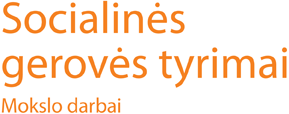Moterų užimtumas Lietuvoje: ES kontekstas
plugins.themes.bootstrap3.article.main69414075c56fa
Santrauka
Kaip pažymėta Europos Bendrijų Komisijos ataskaitoje dėl moterų ir vyrų lygybės, siekiant Barselonoje nustatytų strateginių tikslų, Europos Sąjungos valstybėms narėms iškelti dideli uždaviniai: užtikrinti vienodas moterų ir vyrų užimtumo galimybes ir siekti kuo didesnės moterų integracijos į darbo rinką. Šių problemų sprendimas numatytas valstybių narių nacionaliniuose Užimtumo ir kovos su skurdu ir socialine atskirtimi 2004–2006 m. veiksmų planuose, joms teikiama pirmenybė formuojant ir įgyvendinant įvairias socialinės politikos priemones.
Straipsnio tikslas – įvertinti moterų padėtį Lietuvos darbo rinkoje ir naujausias jų užimtumo tendencijas bendrajame ES kontekste. Tuo tikslu aptariama moterų užimtumo raida mūsų šalyje ir kitose pokomunistinėse valstybėse pereinamuoju į rinkos ekonomiką laikotarpiu, lyginama susiklosčiusi užimtumo struktūra remiantis palyginamaisiais EUROSTAT’o duomenimis, vertinami darbo rinkos segregacijos veiksniai, taip pat analizuojami pastarųjų metų pokyčiai ir išryškinama padėties Lietuvoje specifika.
Straipsnio tikslas – įvertinti moterų padėtį Lietuvos darbo rinkoje ir naujausias jų užimtumo tendencijas bendrajame ES kontekste. Tuo tikslu aptariama moterų užimtumo raida mūsų šalyje ir kitose pokomunistinėse valstybėse pereinamuoju į rinkos ekonomiką laikotarpiu, lyginama susiklosčiusi užimtumo struktūra remiantis palyginamaisiais EUROSTAT’o duomenimis, vertinami darbo rinkos segregacijos veiksniai, taip pat analizuojami pastarųjų metų pokyčiai ir išryškinama padėties Lietuvoje specifika.
plugins.themes.bootstrap3.article.details69414075c8f07
Skyrius
Mokslo straipsnis
Šiam žurnalui suteikta Creative Commons Priskyrimas - Nekomercinis platinimas - Jokių išvestinių darbų 4.0 Unported licencija.
Autorių teisės ir leidybos teisės priklauso Mykolo Romerio universitetui.







